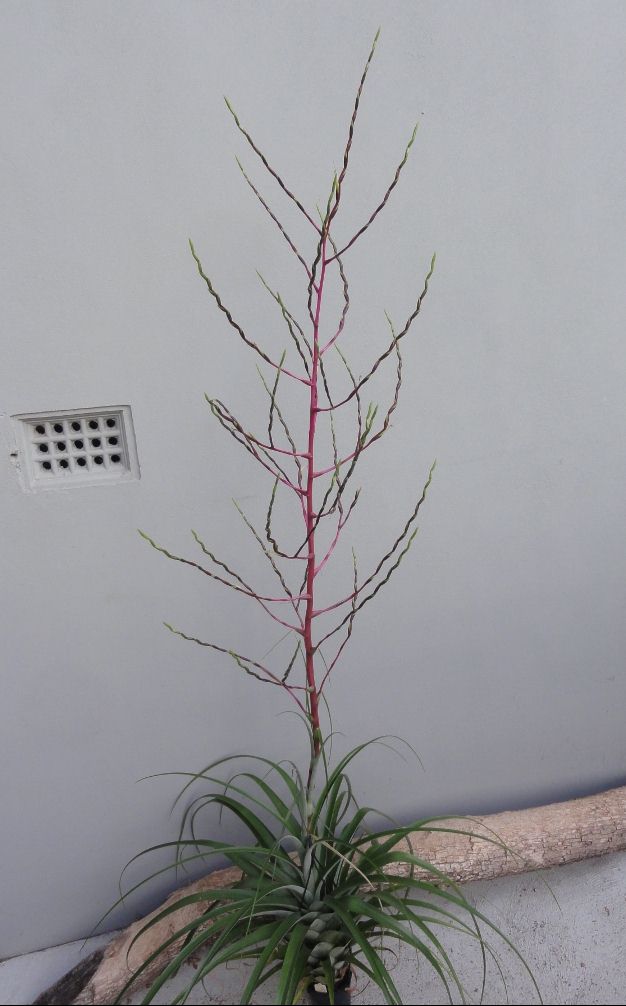
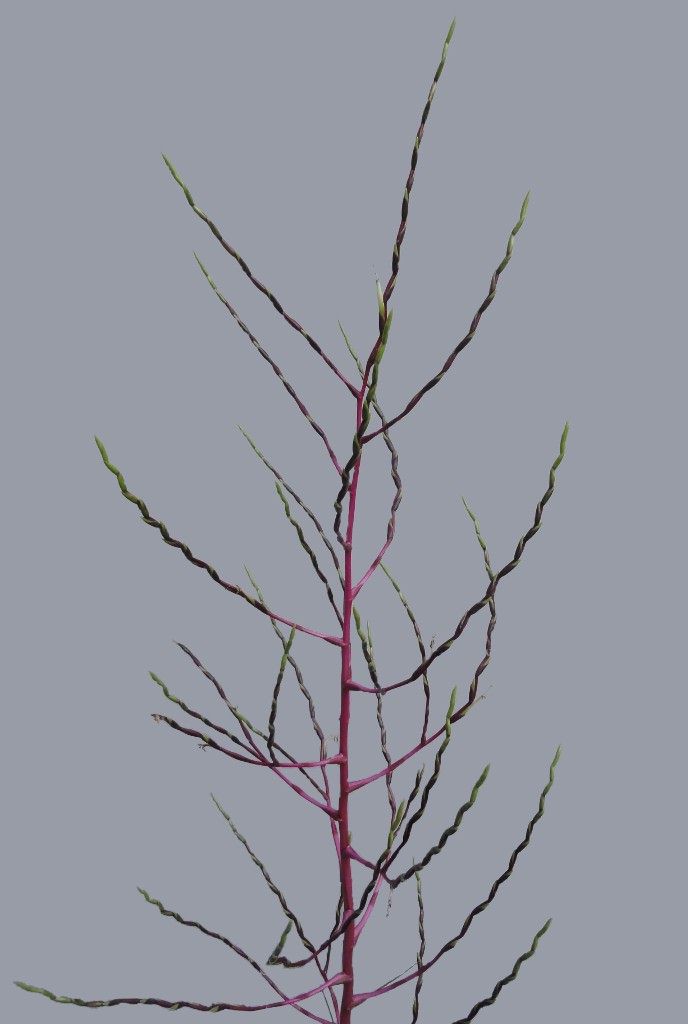
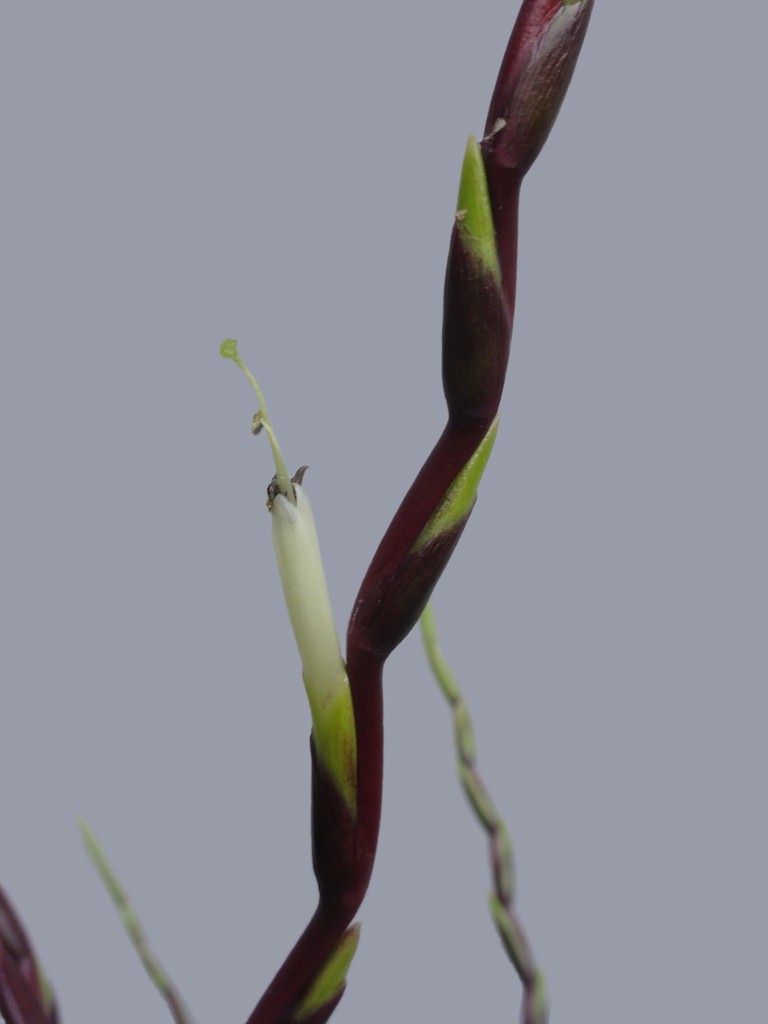
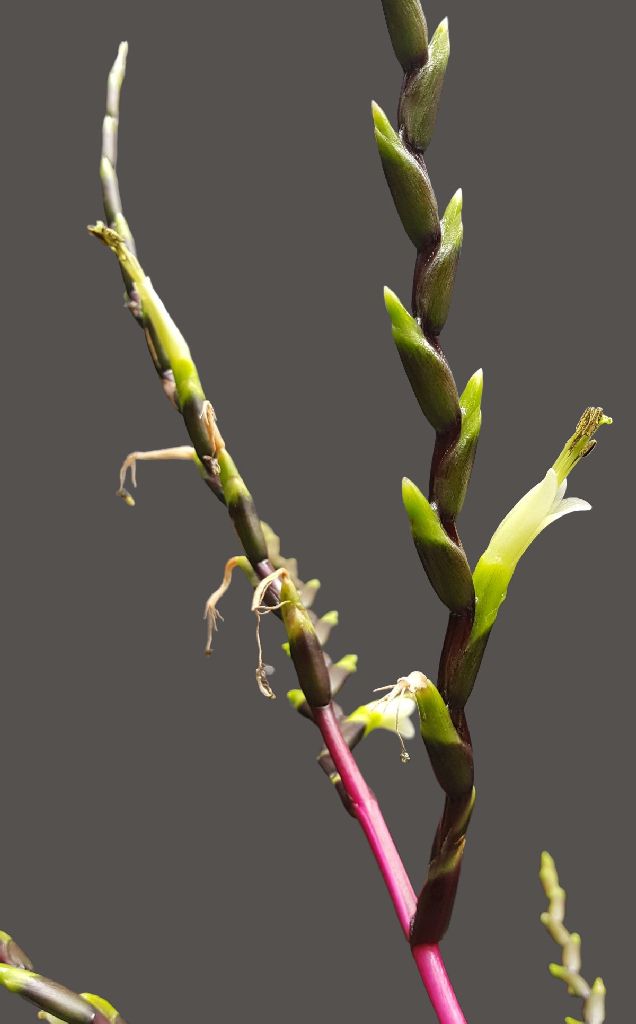
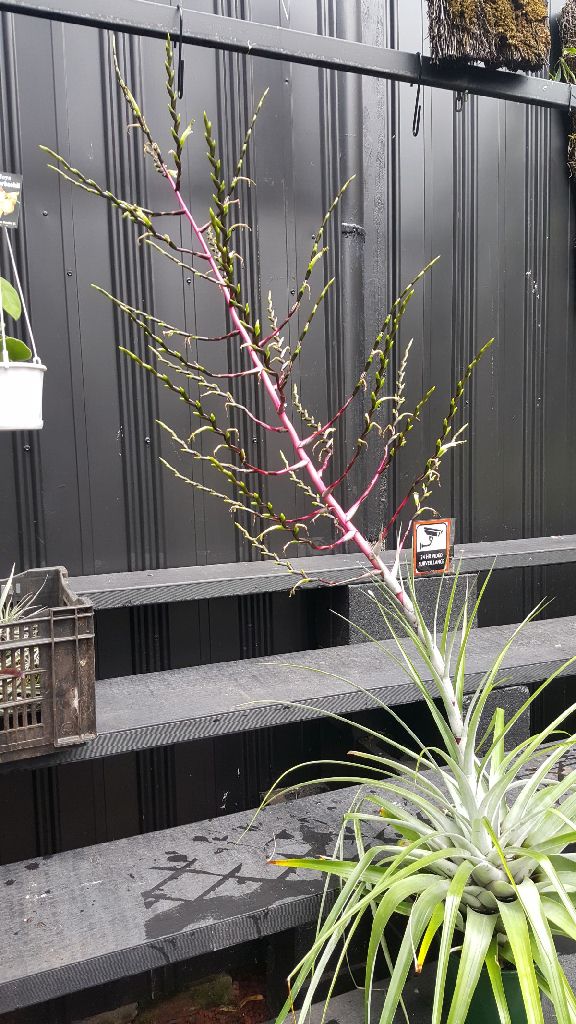
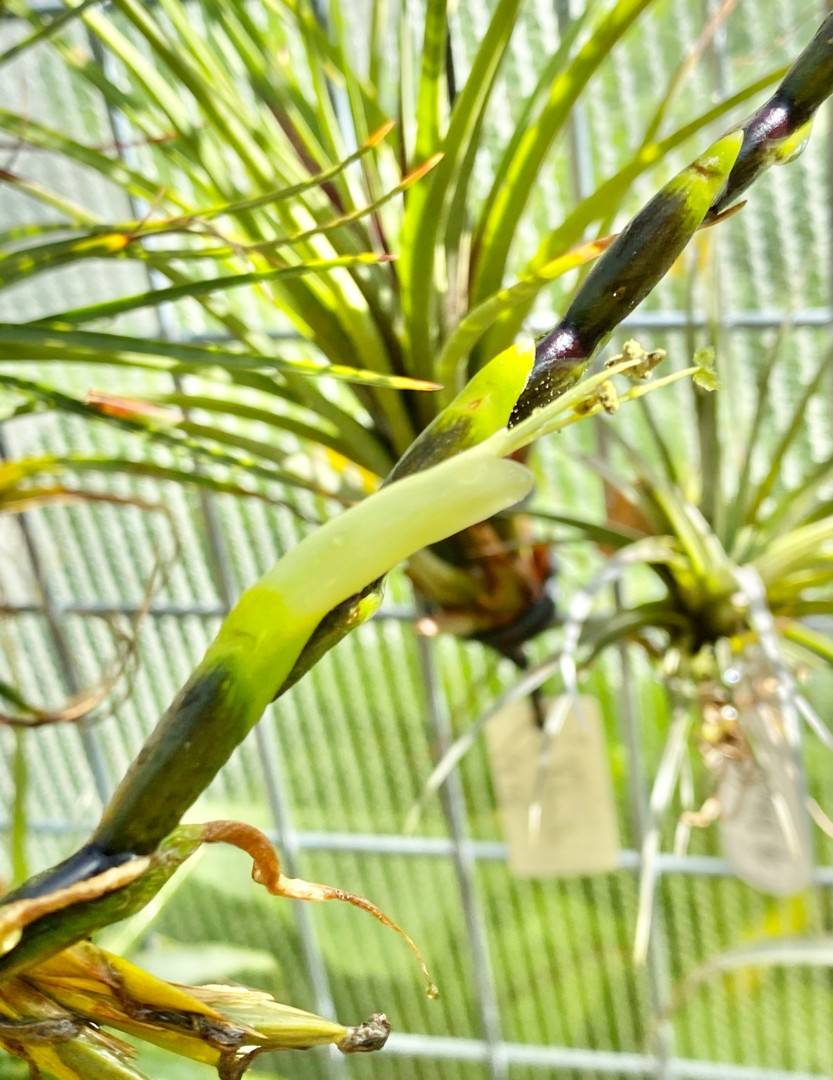
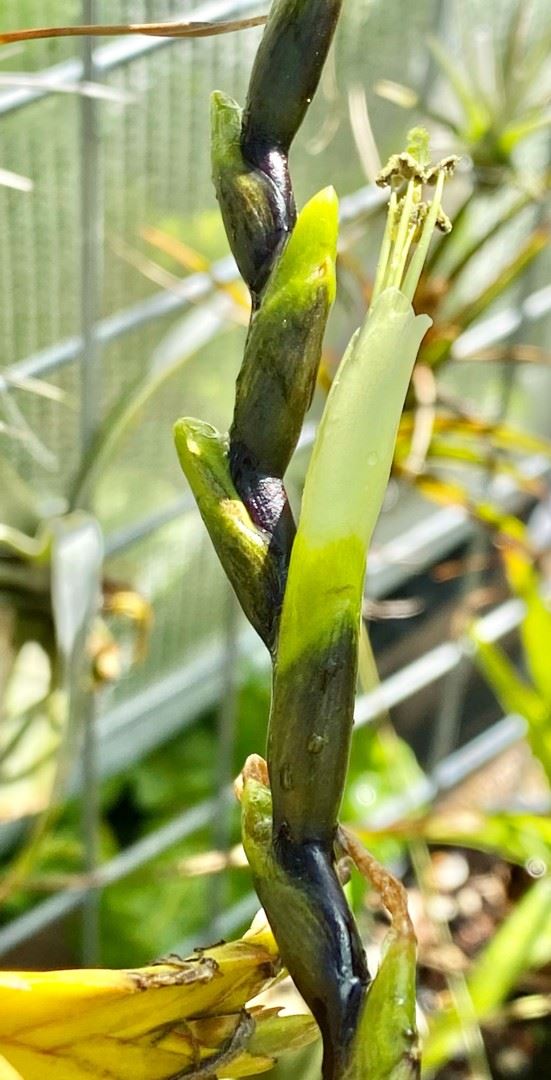
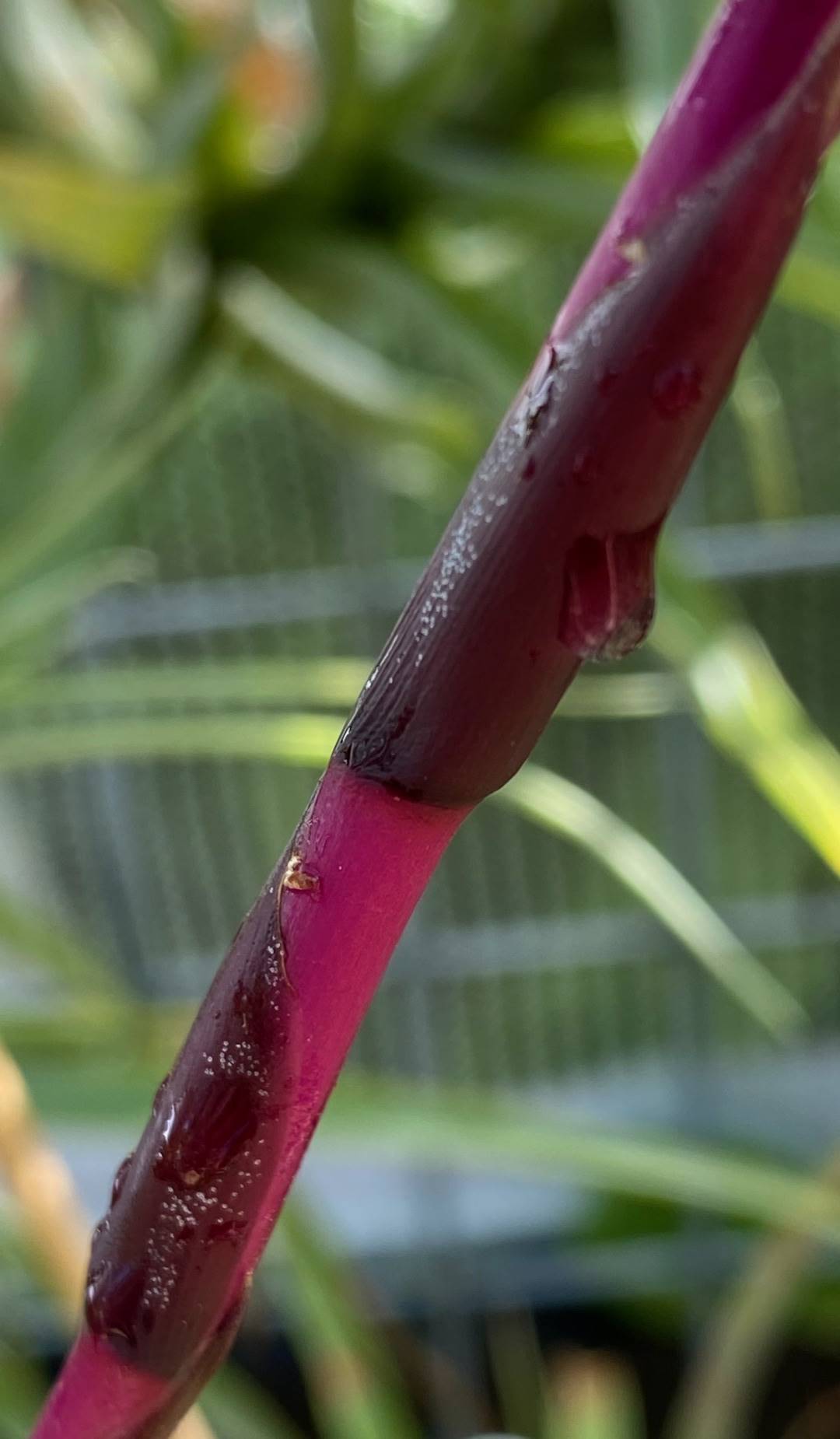


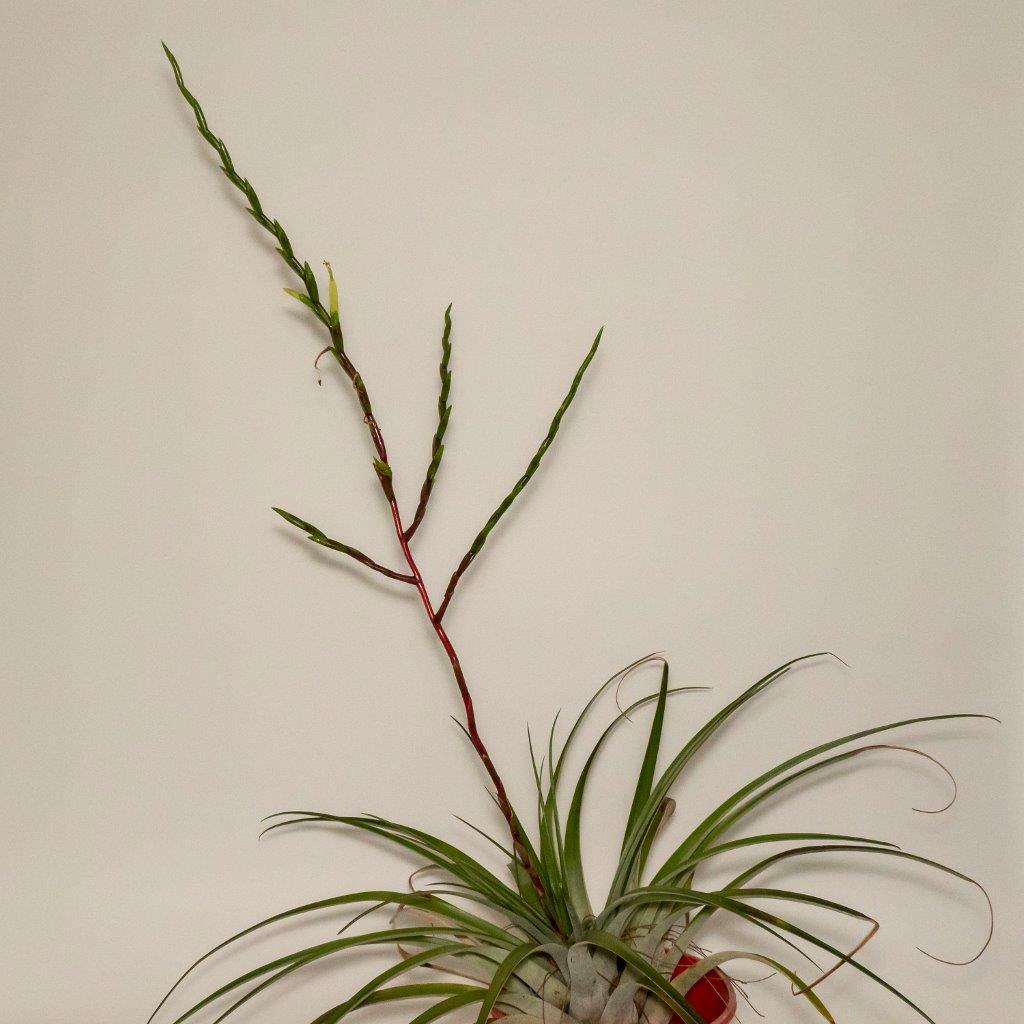
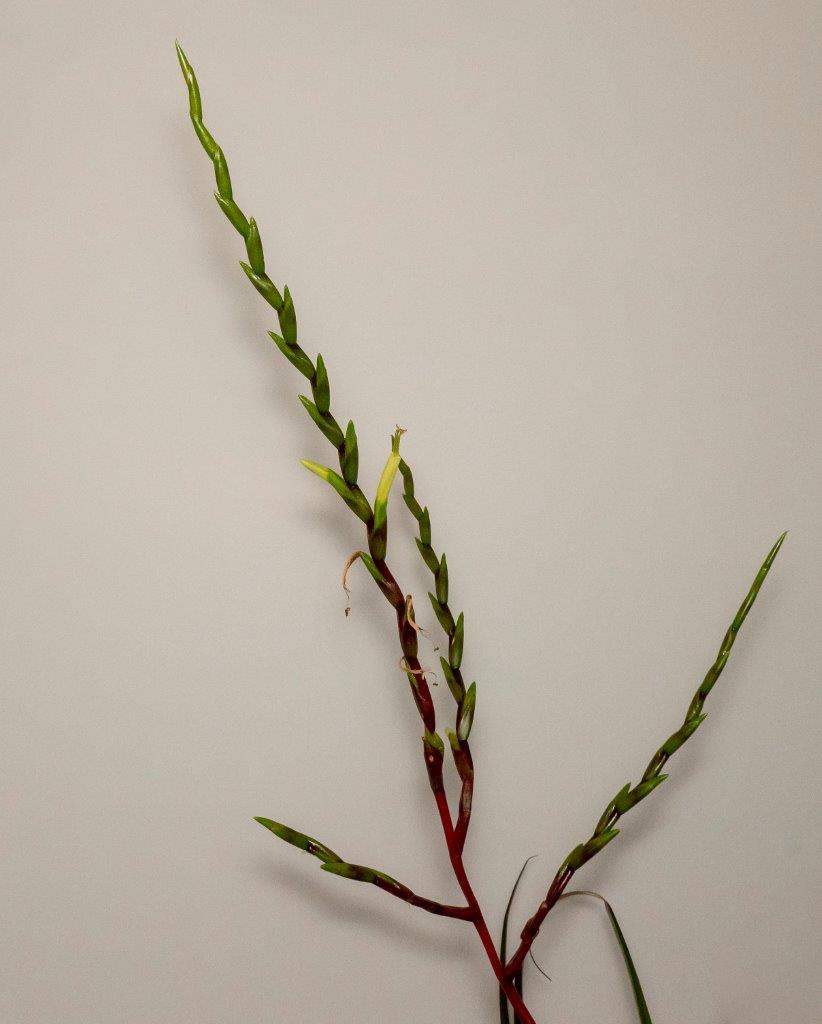
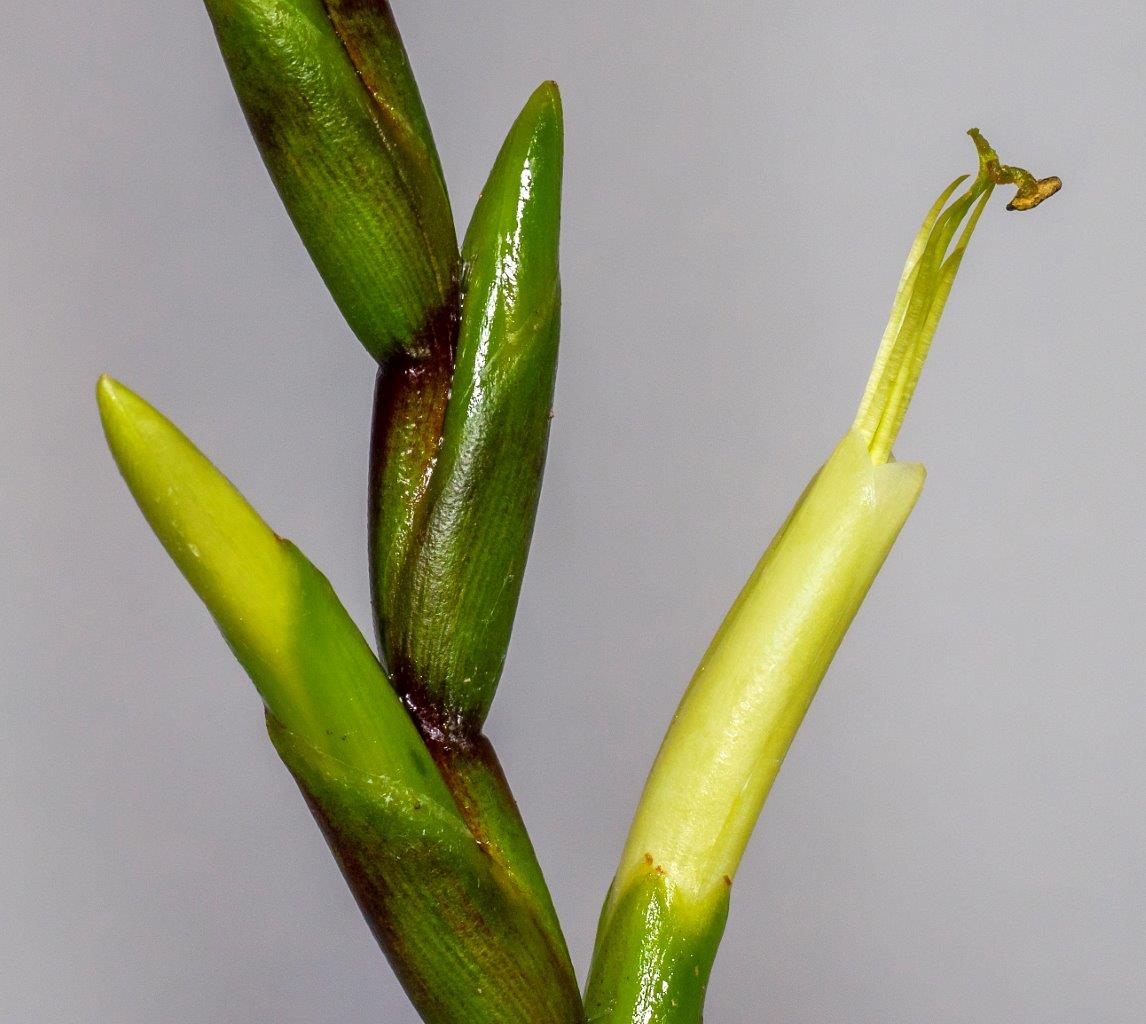
Description from Gardner 1982
ROSETTE: Spreading, funnel form, 30 to 60 leaves, impounding, few offsets.
LEAF: 76 cm long.
BLADE: 30 mm wide, thinly coriaceous, green, glabrous adaxially, lepidote abaxially, dark purple flush on edges in bright light.
SHEATH: 15 cm long, 80mm wide, adaxial surface brown, abaxial concolorous with blade.
SCAPE: Usually shorter than leaves, stout, stiffly erect, purple.
SCAPE BRACTS: Lowest imbricate with reflexed blades, upper remote with short erect blades.
PRIMARY BRACTS: Much shorter than branches, bladeless.
INFLORESCENCE: Bipinnate (rarely simple), branches spread at near 90 degree angle from main rachis.
BRANCHES: Linear, stiff, rachis geniculate, flowers distichous.
FLORAL BRACTS: Broadly ovate to deltoid, glabrous, hard, thin edges, enervate when fresh and dry, remote, proximal portion enfolding rachis (distinct from T. dasyliriifolia which only enfolds the sepals), 23 mm long, 17 mm wide.
SEPALS: Spatulate, glabrous, firm, green, 25 mm long, 6 mm wide.
PETALS: Ligulate, greenish white, thick and firm.
FILAMENTS: Greenish white, 43 and 46 mm long.
ANTHERS: 3 mm long, median attachment, versatile, pollen pale yellow, endothelium black.
STYLE: Greenish, 46 mm long.
STIGMA: Green, lobes papillose, broadly spreading.
FLOWERING: May- July, evening.
HABITAT: Epiphytic in tropical forest, San Luis Potosi, Veracruz and Tabasco, Mexico.
ELEVATION: Sea level to 500 meters.
Although the description (Smith and Downs 1977) has been expanded to include specimens of this species, Baker’s (1987) description of T. dasyliriifolia would exclude them on the basis of their lack of thick and rigid leaves. A photograph of the type specimen was recently published (Weber JBS 1981 p222) which proves this to be an earlier name for Baker's T. geniculata.
Other material examined: MEXICO, San Luis Potosi: Tamazunchale, 1940, Hitchcock & Stanford 6956 (US, WTU), Veracruz: Coatepec, 1957, Foster & VanHyning 3009, (US).
FURTHER information from Gardner in Selbyana vol.7 p372-4 1984
Type: MEXICO: VERACRUZ: Hacienda de las Lagunas, Schiede s.n. (HAL, photo seen).
Type: MEXICO: without exact locality, Morren Icon (K, photo seen).
Tillandsia flexuosa auct. nonSwartz: J. G. Baker, Handb. Bromel. 1889 and L. B. Smith & R. J. Downs, Tillandsioideae in Flora Neotropica Monograph No.14, 1977.
Tillandsia dasyliriifolia auct. non Baker: W. Weber, Herbarium Studies II, Jour. Brom. Soc. 31(5): 222-224, 1981.
Additional material examined: MEXICO: VERACRUZ: Mirador, 1929, Skwarra 19 (GH); San Louis Potosi: lowland forests, Rascon, 1892, Pringle 5306 (GH); Xilitla, 1979, Gardner 835 (SEL) HIDALGO: Huejutla,1946, Moore 2219 (GH); PUEBLA: E of Xicotepec de Juarez, 1979, Gardner 866 (SEL); CHIAP AS: Hwy 195,35 km S of Tabasco state border, 1981, Gardner 1399 (SEL). BELIZE: Belize, O'Neill 8510 (GH); 1970, Liesner & Dwyer 1415 (GH); 11.5 mi. N of Belize, Croat 23274 (GH). GUATEMALA: VERA¬PAZ: Chiquimula, 1885, Watson 49 (GH): ALTA VERAPAZ: Cerro Chinajo, between Finca Yalpemech and Chinaja above source of Rio San Diego, alt. 150-700 m, 1942, Steyermark 45690 (GH). IZABAL: Quirigua, alt. 75-225 m, 1922, Standley 24228 (GH). PETEN: La Libertad, 1933, Lundell 2643 (GH); Lundell2912 (GH).
Distribution: Moist lowland forests of eastern Mexico, Guatemala Belize, and eastern Honduras (san Pedro Sula) (fide Luther) to 800m elevation.
Photographs of Schiede's specimen annotated as the type for T. limbata, published by Weber (1981 ), prove that this species is not a synonym for T. flexuosa. His placement of T. dasyliriifolia as a synonym of T. limbata is apparently based on Mez's citation of the Schiede specimen under T. dasyliriifolia (without mention of T. limbata) (Mez, 1935) and assignment of similar specimens to T. dasyliriifolia by Smith and Downs (1977).
Tillandsia limbata and T. dasyliriifolia are, however, distinct species and are readily distinguished by a full suite of characters. Many of these characters are related to ecology as these species are ecologically separated where their distibutions overlap, T. limbata being restricted to moist forests of high rainfall and T. dasyliriifolia occuring in arid forests or as an epiphyte on cacti or Yucca in deserts.
Baker (1899) described T. dasyliriifolia as having "very thick and rigid leaves" and violet petals. Tillandsia limbata has long, arching moderately thin leaves that are slightly coriaceous, at most, and greenish white petals.
Tillandsia dasyliriifolia belongs to a species complex that includes T. makoyana Baker. This complex displays a mosaic pattern of character combinations and ecologies.
Tillandsia limbata may be distinguished from either of the previous species by the following: floral bracts broadly ovate, enfolding, or nearly enfolding the rachis, quite smooth (fresh or dry), glabrous, never nerved. Floral bracts of T. dasyliriifolia complex specimens are much narrower, not enfolding the rachis (or only slightly) and are typically finely nerved. Living specimens differ in pigmentation of the scape, rachis, and flush of the floral bracts that is No.42 maroon in T. limbata but No.38 rose in T. dasyliriifolia.
On the identification of Tillandsia limbata Schldl.1845 ("1844") by WILHELM WEBER in J Brom Soc 31:222. 1981
In his bromeliad monograph of 1935 in Engler's Pflanzenreich, Carl Mez placed Tillandsia limbata Schldl. into synonymy with Tillandsia flexuosa Sw. And also in the new monograph of tillandsioideae by Lyman B. Smith in Flora Neotropica the author indicates that Till. limbata Schldl. is a synonym for Till. flexuosa Sw., however with the notation that L. B. Smith himself has not seen the type plants of Till. limbata and that identification stems from C. Mez.
While re-examining Schlechtendal's old bromeliad herbarium, which is housed in the herbarium of the University of Halle, I had the opportunity to examine the type plants of Till. limbata Schldl. They consist of a larger - ca. 80 cm. - plant whose inflorescence and rosette are mounted on two separate boards and a second, somewhat smaller plant about 72 cm tall, whose inflorescence is folded over. The notations, written in hand by Schiede, say, "Till. August 29 Hac. de la Laguna" on the larger plant and, "Tillandsia, bracteis violaceis, in arboribus, Hac. de la Laguna Aug. 29" on the smaller plant.
The accompanying photographs of the type samples show clearly that these are not identical with Till. flexuosa Sw. My re-examination shows them to be the same as Till. dasyliriifolia described later by Baker. Mez in his time, too, had substantiated Baker's findings, because the types have been added to his identification noted. This proves that Mez had the type plants of Till. limbata in his hands, and it is simply a mystery today why he then placed them into synonymy with Till. flexuosa Sw.
Priority rules then make the following nomenclature changes necessary: Tillandsia limbata Schlechtendal in Linnaea 18; 1845 ("1844"), p. 419
Synonyms: Till. dasyliriifolia Baker 1887
Till. drepanoclada Baker 1889
Till. geniculata Baker 1889
Till. pulvinata Baker 1889
TYPUS: Schiede s.n., MEXICO, Vera Cruz;
Hacienda de la Laguna, August 1828; HAL 45626
Tillandsia drepanoclada Baker, Handb. Bromel. 188. 1889
Leaves ensiform-acuminate from an ovate base 2 in. broad, 2-3 ft. long, an inch broad low down, moderately firm in texture, nearly naked.
Peduncle stout, much shorter than the leaves;
Bract-leaves with long free points.
Panicle of 5-6 moderately dense arcuate flexuose branches a foot long;
Flower-bracts ovate, acute, rigid, an inch long.
Calyx as long as the bract.
Petal-blade short, oblong.
Hab. Mexico; Chiquihuite, Bourgeau 2193! (Herb. Mus. Paris).
Treated by S&D as a synonym of T. dasyliriifolia.
Resurrected by Serna & Ferrari in Las Monocotiledoneas Mexicanas, 1994 but the herbarium specimen Bourgeau 2193 clearly shows this to be a T. limbata !!
Treated in Checklist of Mexican Bromeliaceae in Selbyana 25(1): 33-86. 2004 as a syn of T. limbata
Tillandsia pulvinata Baker, Handb. Bromel. 190. 1889 treated as a synonym of T. dasyliriifolia in S&D but this species redefined by Ramirez et al in J. Brom. Soc. 54(3): 112-121. 2004
Treated in Checklist of Mexican Bromeliaceae in Selbyana 25(1): 33-86. 2004 as a syn of T. limbata
143. T. PULVINATA Baker, Handb. Bromel. 190. 1889
Leaves about 20, densely rosulate, lanceolate-acuminate from an ovate base 3 in. broad, 11/2 -2 ft. long, 2 in. broad at the base of the blade, tapering gradually to a long point, moderately firm in texture, glaucous beneath.
Peduncle longer than the leaves; bract-leaves all small,
adpressed.
Inflorescence a lax panicle 11/2 ft. long; branches few, lax, subpatent, simple, the lower a foot long; rachises not flexuose; flowers adpressed to the rachis; flower-bracts ovate, 3/4 in. long. Calyx not longer than the bract; sepals oblong.
Petals lingulate, white, twice as long as the calyx.
Hab. Mexico. Described from Prof. Morren's drawing, made April, 1883. Allied to T. flexuosa.
13. T. pulvinata Morr. ap. Bak. Bromel. (1889) 190. Desc from Mez 1935
Metralis vel ultra. Folia ad 0,5 m longa, super vaginam ad 53 mm lata, inde in apicem crasse subulatum sensim angustata, dense lepidibus cinereis obtecta, perrigida. Scapus validus, folia superans, vaginis summis apice rotundatis, quam internodia permanifeste brevioribus praeditus. Inflorescentia multiflora, metralis, ad 0,2 m et ultra diam., ample laxeque 2- vel imperfecte 3-pinnatim panniculata; bracteis primariis vaginis scapalibus isomorphis, quam spicae permulto brevioribus; ramis ascendentibus, basi prophyllis nonnullis auctis, usque ad 0,35 m longis, spicas breviter stipitatas permulti- (ad 30-)floras laxas pinnatas gerentibus; bracteis florigeris stricte erectis, nec imbricatis nec axem valde undulatum obtegentibus, coriaceis, margine membranaceis, haud carinatis, glabris laevibusque, rotundatis, ad 15 mm longis, quam sepala conspicue brevioribus. Flores stricte erecti, certe 40 mm vel ultra longi; sepalis posticis inter sese ad 5 mm, cum antico ad 3 mm connatis, coriaceis, margine late membranaceis, late ovalibus, rotundatis, ad 17 mm longis. Petala sepalis duplo longiora, tubulose erecta, quam stamina breviora.
Mexico: bei Tehuacan (Liebmann n. 41, 42), ohne Standortsangabe (Kienast). Guatemala (Rodriguez). Nicaragua (Oersted).
Plant a metre or more high.
Leaves to 50cm long, 53mm wide next to sheath, then gradually narrowing to a thick subulate tip, covered with dense grey lepidote, very rigid.
Scape stout, exceeding the leaves, upper scape bracts with rounded tips, clearly shorter than the internodes.
Inflorescence many flowered, a metre long, to 20cm or more in diam, paniculate, amply lax, bipinnate or imperfectly tripinnate
Primary bracts similar to the scape bracts, much shorter than the spike
Branches ascending, with some sterile bracts at the base, up to 35cm long,
spikes with very many (to 30), short stipitatel, lax, pinnate, flowers
Floral bracts strictly erect, not imbricate, nor covering the strongly undulate axis, leathery, edges membranaceous, not at all carinate, glabrous becoming smooth, rounded, to 15mm long, conspicuously shorter than the sepals
Flowers strictly erect, definitely 40mm or more long,
Sepals posterior pair connate to 5mm, anterior to 3mm, leathery, edges wide membranaceous, broad ovate, rounded, to 17mm long.
Petals twice as long as sepals, tubular erect, shorter than the stamens
Mexico, near Tehuacan (Liebmann n.41, 42), without locality(Kienast), Guatemala (Rodriguez), Nicaragua (Oersted)
From Baker Handb. Bromel. 190. 1889
142. T. GENICULATA E. Morren (M.D.).
Leaves densely rosulate, ensiform from an ovate base 1½ in. broad, 1½ ft. long, an inch broad low down, tapering gradually to a long point, moderately firm in texture, thinly lepidote. Peduncle 2 ft. long; bract-leaves with long reflexing linear tips. Panicle very lax, 2-3 ft. long; branches arcuate, all simple, ½-1 ft. long; branch-bracts small; rachis very zigzag; flowers ascending ; flower-bracts oblong, greenish-brown, an inch long. Calyx ½ in. longer than the bract; sepals naked, oblong. Petal-blade white, lingulate, shorter than the stamens.
Hab. Mexico. Introduced by M. Kienast, of Zurich. Described from Professor Morren's drawing, made June, 1888. Allied to T. flexuosa.
Type. Morren Icon (K) Mexico without exact location
This complex has not been very well investigated so far because there are many anomalies. I must confess that I also did not pay much attention to this group other than to collect and file specimens. Everything seemed to be well known and the plants are not particularly attractive. They need a long time of cultivation until they flower and most of them are monocarp. Not many collectors of Bromeliads cultivate them in their collections – even the so called tillandsia specialists.
In 1977 we had Flora Neotropica ‘Tillandsioideae” published and this was my first point of reference.
Then I read in the book ‘Bromelien’, by Werner Rauh, that the plant that grows in arid areas with stiff, funnelform and strongly nerved grey leaves and violet petals, is T. makoyana.
This was followed by the publication by Wilhelm Weber in Feddes Repertorium, Vol.95 Heft 9 – 10 587, 1984 where it was said that the plant growing in more humid areas with thinner green leaves forming an open rosette and white petals is T. limbata Schlechtendal, ( syn. T. dasyliriifolia.)
Again in 1984 in Selbyana, Sue Gardner pointed out T. dasyliriifolia as having thick and rigid leaves and violet petals, belonging to a complex that includes T. makoyana Baker, occuring in arid forest or as an epiphyte on cacti or Yucca in deserts.
Reading this comment I became interested in the subject and tried to find out how these taxa were related. But I found out that this is not at all easy work.
I compared the descriptions of T. makoyana and T. dasyliriifolia in Smith & Downs. But I did not find characters for T. makoyana which according to W. Rauh are typical for T. makoyana - a funnelform plant with strongly nerved leaves.
Reading only the descriptions it seemed impossible to identify an actual plant.
Many fellow tillandsia buffs like Harry Luther, Walter Till, Derek Butcher, Virginia and Robert Guess and others are co-operating, discussing and studying the herbarium specimen and try to help me recognise the types. Derek Butcher helped a lot in finding and translating the original descriptions.
So we have the Isotype of Tillandsia drepanoclada Baker and T. pulvinata E. Morren ex Baker where all the experts seem to agree are both synonyms of T. limbata Schlechtendal.
I also examined in September 2003 the lectotype leg Schiede Aug.1829 of T. limbata Schlechtendal 1845 (1844), syn: Till. dasyliriifolia Baker 1887, corr. by Wilhelm Weber 26. 3. 1980 in Herbarium of Martin–Luther Universität Halle-Wittenberg.
I was very glad to see the article on Tillandsia dasyliriifolia Baker by Ivon Ramirez et al, in the Journal of the Bromeliad Society Volume 54(3): 97- 144. 2004 It had been so well researched that I have to agree that this has given me a basis from which to work on allied plants in the complex.
The old descriptions are sometimes very vague and not of real help. And also it is very difficult as Ivon Ramirez has pointed out, if you have only herbarium material. When dry, many important characters disappear, like colour of rhachis, of floral bracts and sepals, texture, nerves and so on. Also it is of importance in what stage the plant has been dried, at anthesis, post anthesis or having seed. Some authors pay much attention to the length of capsule, but I found this also very variable in the same species. If you have only dried material it is nearly impossible to give a good description of a plant.
In the same group growing in Mexico with lax flexuous flowers are T. albida Mez & Purpus T. utriculata Linnaeus and T. karwinskyana Schultes Filius, three species that on the first glance seem to be easy to identify. Sue Gardner gave a very good thesis to separate the latter two plants. She states that T. utriculata and subsp. pringlei has thin white petals that twist apically at anthesis forming a lateral aperture and distinct zygomorphy, the lobes of stigma are twisted many times and very small and not at all spreading. T. karwinskyana has chartreuse petals, firm and actinomorphic and only slightly irregular with a closed throat, the lobes only slightly twisted, very long and thin and spreading. But in nature things are not so easy to separate: We found on the road to Guadalajara near Presa Achoquen tillandsias (EM 8192, collected 1981) that look like T. karwinskyana or T. utriculata subsp. pringlei but they did not fit the norm: they had firm charteuse and only slightly irregular not zygomorhic petals like T. karwinskyana, but they have a distinct corola aperture like T. utriculata and the lobes of stigma also are small and not spreading like T. utriculata.
So it is evident, there are more questions than answers and more investigation is needed in this part of the group.
I have tried to collect for many years as much material as possible. The violet flowering specimens are very difficult to separate because sometimes the inflorescences are nearly identical but the shape of the plant and the leaves are different. (photo of T. spec. EM 030505 and EM 030506, Oaxaca, Lachiguiri, 1300 m s. m., shows two plants collected only 50 m apart in the same area, the plants look very different, but the inflorescences are nearly identical in the floral characters.) There are many instances of slightly different plants throughout Mexico and this makes things so complicated.
In Flora Neotropica we see T. cucaensis Wittmack treated as a synonym of T. makoyana Baker. During my investigations into this group I found in my files a plant from Rio Dulce, Guatemala which fits nearly exactly the description of T. cucaensis including the pale green petals.
So I add this Tillandsia to the plants mentioned in this article and compare it with the characters I observed for Tillandsia makoyana. This seems to be necessary to show the different characters of T. cucaensis.
I would like to present 3 new species that are so different in so many characters that I think they should be described. Two of them belong to the group of the white-flowered Tillandsias and one of them has very unusual red-coloured petals.
For the differential diagnosis of the plants I use the lectotype leg Schiede Aug.1829 of T. limbata Schlechtendal 1845 (1844), in Herbarium of Martin–Luther Universität Halle-Wittenberg which I examined in September 2003.
I found plants that exactly fit the lectotypus Schiede for T. limbata Schlechtendal in Chiapas and Veracruz at different locations. I also used photos and detail to compare with T. limbata EM0301301, collected 8. 2. 2003 in Chiapas, Laguna Belgica 1000 m.
Robert and Virginia Guess sent me a photograph which shows T. utriculata, T. limbata and a new spec. which I describe as T. comitanensis, flowering at the same time at the location. They did much exploration and field–work in Chiapas. My best thanks to them for the photo, for the interesting discussions in Chiapas and their answers to questions posed in many E-mails
plant: many leaves, open rosette
leaves soft, sheats 6- 8 x 4 – 6 cm, adax. brown, abaxial green - light brown, blades narrowly triangular, recurved, dark green, finely adpressed lepidote, abaxially more.
Scape: much surpassing the rosette, 30 – 50 cm long, bright red,
scape bracts: the sheats to 4 cm long, adpressed to the scape, the blades of the lower ones foliaceous, the upper ones with thread thin blades.
Infl. laxely bipinnate, spikes to 30 cm long, (inclulding a to 5 cm long red stipe with sterile bracts,) primary bract 2,5 – 3,5 cm long, rhachis strongly geniculate and visible, flowers adpressed to the rhachis and and 2/3 of the length contiguous with it, internodes between the flowers 15 mm, flowers with sinus.
Floral bracts 2 cm long, 1,5 cm wide, ovate, obtuse 2 – 3 mm shorter than the sepals, covering ¾ of the sepals and and 2/3 of the rhachis, ecarinate, coriaceous with thin margins, if dried slightly nerved towards apex, greenish yellow.
Sepals to 2 – 2,4 cm long, 8 – 9 mm wide, narrowly elliptic, subobtuse, free, ecarinate, coriaceous with hyaline margins.
Petals to 3, 5- 3,8 cm long, 6 – 7 mm wide, ligulate with sinus, whitish yellow, throat nearly closed.
Stamens exerted, filaments to 4,5 cm long, greenish, anthers 3 mm long, 1 mm wide, versatile attached 1/3 from base, pollen egg-yellow, style 4,3 cm long, greenish, stigma 3mm long, 3 mm wide, lobes papillose, broadly spreading.
Plant examined: EM 030101, Chiapas, Ocozucuautla – Apipac, Laguna Belgica 1000 m.
Other material of the same plant examined:
Chiapas, El Paraiso – Cascadas 1000 m s. m., 8. 2. 03, EM 030702 collected postfloral and 1 plant is flowering in June 2003 in collection Ehlers.
Veracruz, Costa Esmeralda, Mex 180 km 29, 63 m s.m, Papantla 22. 2. 03 EM 032103, collected postfloral, and 1 plant flowering in collection Ehlers in June 2003, many plants near the ruins of Tajin; Road Mex 130 to Huchinango km 128, 1400 m EM 032105.
The plant grows from sea level to 1400 m, it grows in dry habitats like near Papantla and Tajin, and in moist areas like near Laguna Belgica.
T. EM031301 compared with description from Weber T. limbata Schlechtendal 1845 and Lectotypus HAL, Syn T. dasyliriifolia Baker 1887, - T. Drepanoclada Baker 1889, T. geniculata Baker 1889, - T. pulvinata Baker:
The plant fits exactly the description of T. limbata Schlechtendal 1845.
Rosette and leaves nearly the same, spike and primary bract same, internodes of the flowers 15 mm, floral bracts 2 cm, covering the base of sepals and part of the rhachis, sepals 24 x 8 mm, all details fit exactly.
T. EM031301 compared with Isotypus: Tillandsia drepanoclada Baker and with a herbar from Selby Herbarium T. af. drepanoclada Baker, determino: a. Espejo y A. R. Lopez-Ferrari: Foliage green, Scape red. Vic. Ocozocoautla. Alt. ca. 1000 m Prov. Chiapas (this is exactly the same habitat as EM031301):
I can not find different characters, the plants are very similar.